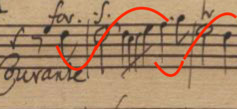Applying knowledge acquired in the dance workshops - my Beat-Box method
(V2aT2)
As demonstrated in the video essay V1a (throwing gesture), each performance challenges its predecessors in the length and height of the throwing or lifting gestures. But if the narrative of Sancho’s punishment allows, or even invites such a competition, the dance structure sets some limits to the height of the jumps and the length of the suspensions.
One day, after what I thought was a successful performance, someone remarked: ’...your Courante sounded like a folky Hornpipe! Fast, ferocious, and jumpy!' I could feel it was not meant as a compliment and my ignorant answer was something along the lines of ’…if it works musically, who cares whether or not I play it as a real dance!?’ I simply followed my musical instinct. It did say forte, and the bass line transition in the previous bar would work for any rock band. So why not go for it?!
I was afraid that a more literal application of the dance structure would limit my spontaneous music making. In comparison to the Don Quichotte study (V1), where I could relate to most of the gestures from my own experience (throwing, jumping, fighting, sighing), in baroque dance I had very few personal, embodied references.
In the workshops with dancer and choreographer Deda Cristina Colonna I learned the basic steps and hand gestures of baroque dance [1]. While it gave me an idea of the dance structures from a dancer’s point of view, I realized that within the scope of this project I would not be able to learn sufficiently the technique of the steps in order to draw conclusions based on my own dancing. Rather, I would have to find a way to translate the observations and experiences of dancing directly into my violin playing movement vocabulary.
Arnie Cox identifies what he terms ‘sub-vocal representations’ of melodic and rhythmic patterns which connect the bodily experience of singing with that of instrumental musical performance (Cox, 2006). Here, the process of perception or recollection of a specific melodic or rhythmic motive triggers a mirror reaction in the vocal cords, as if singing along silently. I needed to develop a method which, building on similar principles, would allow me to translate my basic knowledge of dance steps directly into my violin playing.
I observed the way dancers create cues that coordinate steps and other bodily actions in a choreography. The way in which movement sets in a choreography are represented as abstract numerical sequences and words, gave me an idea of how to translate dance steps into bowing patterns [2]. Based on a combination of a dancer’s way of counting and non-verbal articulations of musical structures drawn from my own musical practice (ta-daa, pam-pa-paa, trum-ta-ta-taa), I devised a 'beat-box' system similar to the shorthand conversations that I had observed between dancers. This was an oral approach to establishing a structural understanding of the rhythmical grid of the dance which triggered the respective bowing action and body movement.
In the audio example below I introduce this beat-box method, applied to the Courante. From then on, the Gesturist strategy of embodying the dance patterns will draw on the beat-box method.

Ex. 1 & Aud. 1 The structural features of the Courante are here represented in the beat-box pattern. The energy of the sub-voiced articulation of the pattern triggers the 'lift' in the body movement.
The beat-box representation of the Courante dance structure reflects the lifting impulse of the downbeat gesture, that carries the energy through the rest of the bar. The upbeat preparation, together with the downbeat lift, constitute a unified gesture.
In my assimilation of the beat-box pattern (amplified in my body movements) I focused on the kinaesthetic quality of dance movements: the initial upbeat sink (plié), downbeat lift (élevé), and the hierarchy of the rhythmical patterns (step-units). Even though I am far from a skilful dancer, I felt I found a tool to situate my body movements in relation to the dance structure.
In the following section I briefly review the terminology of some dance structures, steps, and movements, and discuss how I apply them in violin playing.
I organized a series of dance and gesture workshops with Deda Cristina Colonna in the Autumn of 2011. The workshops involved the singing class of the Malmö Academy of Music, and led to an opera performance in January 2012 at Palladium in Malmö. The performance was a part of my 25% Seminar.
Note 1
Dalen (2013) describes a similar tool devised by his dance teacher Ana Yepes, who ’developed a system of sounds similar to that of Indian dance to facilitate the execution and analysis of dance steps’ (Dalen, 2013, p. 34). She calls it SSAP, systhème sonore d’analyse des pas. As this system is still under development I could not apply it in my thesis.
Note 2